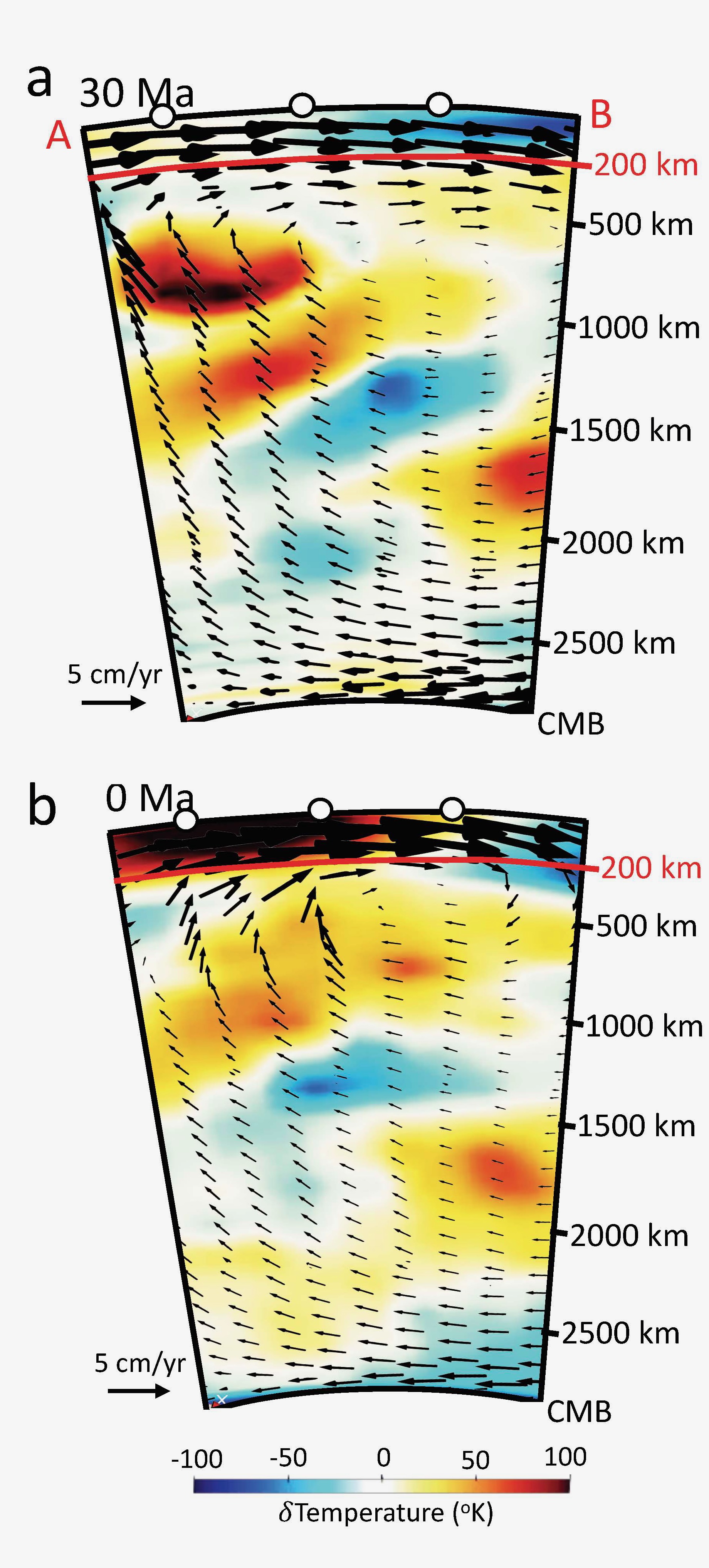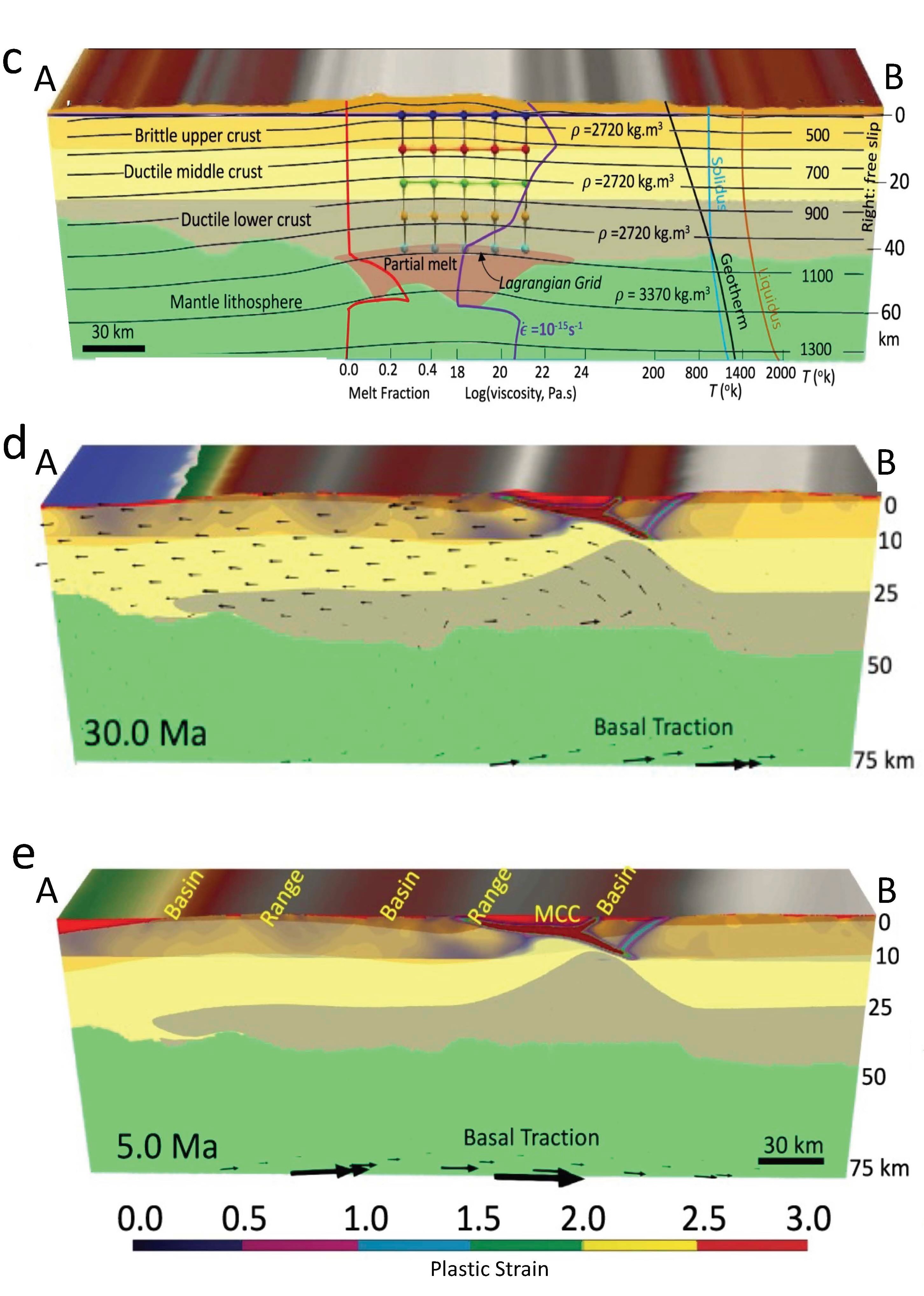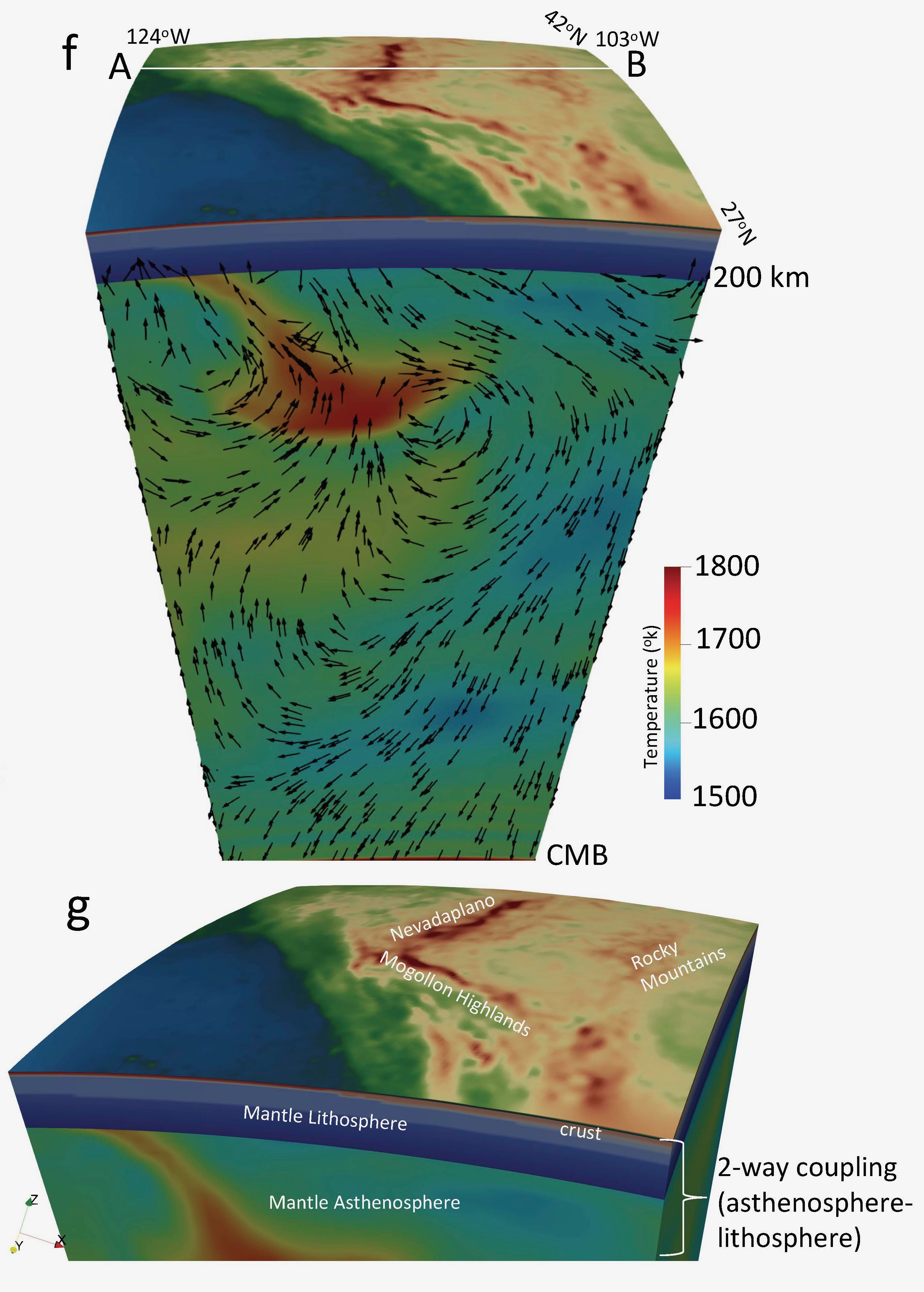February 2023
- Details
- Parent Category: resources
- Published on Tuesday, 31 August 2021 19:29
Coupling mantle convection (ASPECT) to lithosphere and surface processes to understand North American tectonics
Dramatic topographic extension, an unparalleled suite of data from field observations and EarthScope, and well-constrained plate boundary evolution make the western United States a world-class natural laboratory for studying the thermomechanical processes of extensional collapse. The present-day Basin and Range province of Southwestern North America (SWNA) is the product of this complete period of extension. The extensional period is generally recognized to consist of an early phase in latest Eocene-Oligocene, in which metamorphic core complexes formed through evolution of low-angle normal faults that eventually exhumed highly sheared middle-crustal rocks (Bahadori and Holt, 2019).
In a pair of studies we model mantle flow using ASPECT (Advanced Solver for Problems in Earth’s Convection) (Figure 1a,b) and couple output stress field to a lithosphere model using UWG (Underworld Geodynamics) (Beucher et al., 2019) (Figure 1c,e). The modeling incorporates non-linear visco-plastic behavior of the lithosphere, and it accounts for the weakening effects of crustal partial melting, and mantle flow related dynamic topography (Figure 1c). Implementation of external forcings like upper crustal velocities, paleoclimate, and sea-level fluctuation drive landscape evolution in the Badlands code (Salles, 2016) including sedimentation and erosion, which feed back into the lithosphere model.
Our simulations for the SWNA result in an early thickened crustal welt that was heated and weakened through the generation of partial melt, leading to extensional collapse, in 3-D of the highlands and flattening of the underlying Moho (Bahadori et al., 2022a). This model performs well in matching inferred fault motions and directions during the collapse of topography phase and accurately predicts deposition of sediments in basins that contain the mammal fossil and climate records (Loughney et al., 2021). With modeling of the extensional collapse along E-W cross sections of the Nevadaplano we find that a major detachment fault forms as the crustal root rebounds and the Moho flattens (Bahadori et al., 2022b) (Figure 1c-e). The detachment transfers middle crust up to the surface into a domed upwarp structure (metamorphic core complex). We show that these metamorphic core complexes arise because of the body forces, owing to the starting topography that is supported by a crustal root and therefore argue that the belt of metamorphic core complexes in the SWNA constitute a fossil signature of a thickened crustal root.
Coupled models can be used to better explain the present-day topography and crustal structural settings that resulted from extensional collapse of highlands, development of individual basins, and evolution of major detachment faults that have the potential to exhume and expose middle crustal rocks at the surface (metamorphic core complexes) in 3-D. An additional advance and planned future work includes the full/two-way coupling of these lithospheric body forces and mantle flow (ASPECT) to predict the time-dependent thermomechanical response at high resolution in 3-D, specifically within the crust (Figure 1f, g).
Contributed by:
Alireza Bahadori and Jacqueline Austerman, Columbia University
References
Bahadori, A., Holt, W.E., Feng, R., Austermann, J., Loughney, K.M., Salles, T., Moresi, L., Beucher, R., Lu, N., Flesch, L.M., Calvelage, C.M. et al., 2022a. Coupled influence of tectonics, climate, and surface processes on landscape evolution in southwestern North America. Nature Communications, 13(1), pp.1-18.
Bahadori, A., Holt, W.E., Austermann, J., Campbell, L., Rasbury, E.T., Davis, D.M., Calvelage, C.M. and Flesch, L.M., 2022b. The role of gravitational body forces in the development of metamorphic core complexes. Nature Communications, 13(1), pp.1-19.
Bahadori, A. and Holt, W.E., 2019. Geodynamic evolution of southwestern North America since the Late Eocene. Nature communications, 10(1), pp.1-18.
Beucher, R., Moresi, L., Giordani, J., Mansour, J., Sandiford, D., Farrington, R., Mondy, L., Mallard, C., Rey, P., Duclaux, G. and Kaluza, O., 2019. UWGeodynamics: A teaching and research tool for numerical geodynamic modelling. Journal of Open Source Software, 4(36), p.1136.
Loughney, K. M., Badgley, C., Bahadori, A., Holt, W. E., Rasbury, E. T., 2021. Tectonic influence on Cenozoic mammal richness and sedimentation history of the Basin and Range, western North America. Science Advances, 7(45).
Salles, T., 2016. Badlands: A parallel basin and landscape dynamics model. SoftwareX, 5, pp.195-202.

Figure 1 a&b. Radial cross-sections of the reconstructed mantle temperature variations, using ASPECT, from surface to core–mantle boundary (CMB) along the line A–B at latitude 37oN.

Figure 1 c. Model set-up and boundary conditions for the thermomechanical simulations, using UWG, that include partial melting in the deep crust. d&e. The evolution of crustal structure together with the magnitude of the finite plastic strain for the brittle upper crust showing the development of a major detachment fault, uplift of deeper rocks, metamorphic core complex development, and sedimentation from surface erosion. These processes of metamorphic core complex development occur after a thickened crustal root supporting topography is weakened through the introduction of heat, fluids, and partial melt.

Figure 1 f & g. A representation of the model set-up with ASPECT, at the late Eocene in SWNA, for a future work forward model simulation that includes a two-way coupling between asthenosphere and lithosphere. CMB: core-mantle boundary, MCC: metamorphic core complex.
